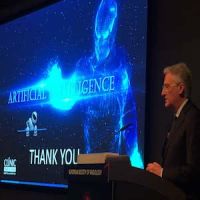Artificial Intelligence, AI, augmented reality, AR, deep learning, machine learning, algorithms. These terms were the ‘stars’ at the European Congress of Radiology in Vienna this year. In the sessions, on the exhibition floor in the corridors, elevators and cafes- radiologists, clinicians, physicians, programmers were talking and learning about AI in terms of the realistic applications in existing radiological workflows, the real potential and value these tools have to offer.
Deep learning has become possible as a result of the increasing computing power available and AI and machine learning are finding their place in the radiological care continuum. Radiology and the ECR- true to it’s values and mission- have been at the forefront of these innovations and it is becoming increasingly more apparent that radiology as a practice will change and evolve with AI.
You may also like: AI is the new reality: the 4th healthcare revolution in medicine
Machine learning use in radiology is also gaining traction as an interdisciplinary research field. Moving beyond the initial expectations to transition into joint research, this year the vibe was more of a general consensus to make “a reality check” and understand where the field is and which are the most promising and challenging efforts for this emerging interdisciplinary field.
A multitude of sessions overviewed of the current state of AI, machine learning and emerging technologies in medical imaging and explored valuable directions of joint research.
The room had literally no floor space left during the session "Artificial Intelligence (AI): driven by radiologists" chaired by Professor Elmar Kotter, as attendees stood and crouched over every available square centimetre of the floor. Elliot L. Siegel professor of Diagnostic Radiology and Nuclear Medicine and Vice Chair of Information Systems at the University of Maryland School of Medicine presented a talk on how to know the challenges of knowledge management in radiology, the advantages of machine learning technologies compared to traditional approaches and the technical limitations of machine learning. He referred to radiologist “burnout” having reached a “tipping point”. Despite improvements in PACS and EMR's, “Radiologists are still being told to work faster as the screws continue to tighten; more images, greater case volume, increasing complexity and less time to do the work”.
Radiologists are increasingly asked to perform quantitative analysis on complex dynamic studies such as prostate and breast MRI, analyse multi-parametric imaging from MRI, PET, CT, and to follow new guidelines for lung cancer and other screening studies. Deep learning represents a fundamentally different approach to the development of algorithms for image acquisition, quantitative analysis, and interpretation based on learning by example from large image sets. It offers numerous advantages over more “traditional” Computer Aided Design approaches including decreased time, and less specialised medical imaging expertise required for development as well as the potential for continuous and personalised refinement of algorithms. In fact, deep learning may actually have its greatest initial success in solving non-image related challenges such as image quality, workflow efficiency, improved communication and patient safety. This technology, however, is also fraught with limitations including the requirement for large amounts of annotated data, regulatory, medicolegal, and relative brittleness with regard to lack of generalizability from a few to a multitude of different scanners. Overall, despite the challenges, he concluded that deep learning will undoubtedly have a major impact in the next several years on positively resetting radiology’s current “tipping point”.
Prof. dr. Wiro Niessen director of the Biomedical Imaging Group Rotterdam presented "How to integrate AI technology in radiology today." The combination of big data and artificial intelligence are dramatically increasing the possibilities for prevention, cure and care, and are changing the landscape of the healthcare system. Biomedical imaging data will play a central role in this revolution. In this presentation, he presented examples of possible significant benefits of big data analytics of imaging, genetic and clinical data in dementia and oncology. Both conventional machine learning techniques, such as radiomics for tumour characterisation, and deep learning techniques that directly learn from the imaging data. Also, the concept of deep imaging, full integration of medical imaging and machine learning, was discussed. He also highlighted the challenges of how to successfully integrate these technologies into the daily clinical workflow.
Dr. Hugh Harvey, Clinical Artificial Intelligence and Predictive Analytics Researcher, King’s College London presented "How will the introduction of AI change the role of the radiologist?" where he overviewed how machine learning technologies may play a role in the workflow and task automation of radiologists, from appropriateness criteria to image acquisition, to image perception tasks and report generation, he addressed issues relevant to the entire ecosystem of diagnostic radiology and AI in the coming years.
In the session “Artificial intelligence (AI): our future cannot be predicted, but we have to be prepared” four distinguished speakers from areas covering radiology, machine learning and medical image computing talked about the reality versus the hype and presented their views on the directions that will advance the relevant fields having an impact on research in novel biomarkers, and clinical applications. The session highlighted challenges in methodology, the integration of machine learning in radiological routine, and the enablers of successful development of novel and reliable machine learning approaches in medicine. As both fields evolve, and the role of radiology and machine learning is expanding, the session provided a forum for critical, informed discussion.
The session was chaired by Georg Langs, head of the Computational Imaging Research Lab (CIR) at the University Clinic for Radiology and Nuclear Medicine at the Medical University of Vienna, the session tackled the basics of machine learning and deep learning with a presentation by Bram van Ginneken, AI for lesion detection and characterisation presented by Bram Stieltjes. A powerful and informative presentation on machine learning in medical imaging going forward by Prof. Pollina Golland, from the Computer Science and Artificial Intelligence Laboratory at the Massachusets Institute of Technology in Boston; and what impact does AI have on medicine presented by Stefan Schonberg from the University of Mannheim.
While there is a strong increase in AI and the potential of diagnostic systems to be trained to perform with high accuracy and with every vendor bringing AI enhanced diagnostic systems, there are still questions and concerns surrounding the use of AI in radiology.
The most prevalent being:
• the issue of generating and curating high quality datasets of annotated radiological exams needed to train algorithms
• the question of integrating AI into existing workflows and whether or not it can enhance productivity and quality of radiologists work
• the recurring ‘black box’ hurdle of validating AI systems and monitoring consistency
• the ways in which the introduction of AI will change the role of radiologists and how should new radiologists be trained and prepared for working with AI
• the emerging of new subspecialties and the need to augment the ‘radiologist’ with the addition of physics, or programming skills
Of course the many ethical considerations of introducing AI systems into the clinical scene, such as who will ultimately be accountable for the diagnosis, will it be the radiologist, or the vendor of the AI system. The issue of data ownership and the commercial ramifications of the leveraging and use of data.
It was clear, nevertheless, AI will be driven by radiologists and the question of whether AI will replace the radiologist seems to be put to rest, with radiologists viewing AI as the tool that will enhance and aid the discipline.
Source: HealthManagement.org live coverage
Image Credit: HealthManagement.org live coverage
References:
Latest Articles
Radiology, Artificial Intelligence, Radiologists , #ECR2019
Artificial Intelligence, AI, augmented reality, AR, deep learning, machine learning, algorithms. These terms were the ‘stars’ at the European Congress of Radiology in Vienna this year. In the sessions, on the exhibition floor in the corridors, elevators a



























